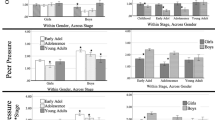Abstract
The purpose of this study was to (a) add to the current literature on female identity development and (b) determine whether a gender specific pattern of identity formation is evident in females during their early and middle adolescent years. The Measures of Psychosocial Development (MPD) was administered by graduate students to 317 males and 332 females in sixth, eighth, tenth, and twelfth grades from schools in a small and a mid-sized mid-western city. The schools were selected because they were representative of the racial/ethnic status of the cities (African American, 12%, Asian American, 4%, European, 63%, Latino, 10%, and Native American, 6%; 5% did not state their ethnicity). The results of the two by four analyses of variance (gender by grade) indicated that females blend interpersonal and intrapersonal identity development, whereas males appear to develop only intrapersonal identity. Limitations and recommendations for future research are also included.
Similar content being viewed by others
REFERENCES
Archer, S. L. (1985). Career and/or family: The identity process for adolescent girls. Youth and Society, 16, 289-313.
Archer, S. L. (1992). A feminist's approach to identity research. In G. R. Adams, T. P. Gullotta, & R. Montemayor (Eds.), Adolescent identity formation. Newbury Park, CA: Sage Publications.
Archer, S. L. (1993). Identity in relational contexts: A methodological proposal. In J. Kroger (Ed.), Discussions on ego identity. Hillsdale, NJ: Lawrence Erlbaum Associates.
Bem, S. L., & Lenney, E. (1976). Sex typing and the avoidance of cross sex behavior. Journal of Personality and Social Psychology, 33, 48-54.
Deaux, K. (1984). From individual differences to social categories. American Psychologist, 39, 105-116.
Douvan, E., & Adelson, J. (1966). The adolescent experience. New York: John Wiley & Sons.
Enns, C. Z. (1991). The “new” relationship models of women's identity: A review and critique for counselors. Journal of Counseling & Development, 69, 209-217.
Erikson, E. H. (1968). Identity: Youth and crisis. New York: W. W. Norton.
Erikson, E. H. (1980). Identity and the life cycle. New York: W. W. Norton.
Gilligan, C. (1982). In a different voice. Cambridge, MA: Harvard University Press.
Gilligan, C. (1987). Adolescent development reconsidered. New Directions for Child Development, 37, 63-92.
Gilligan, C. (1988). Two moral orientations: Gender differences and similarities. Merrill-Palmer Quarterly, 34, 223-237.
Grotevant, H. D., Thorbecke, W., & Meyer, M. L. (1982). An extension of Marcia's identity status interview into the interpersonal domain. Journal of Youth and Adolescence, 11, 33-47.
Hawley, G. A. (1988). MPD measures of psychosocial development professional manual (3rd ed.). Odessa, FL: Psychological Assessment Resources.
Hodgson, J. W., & Fischer, J. L. (1979). Sex differences in identity and intimacy development in college youth. Journal of Youth and Adolescence, 8, 37-50.
Hopkins, L. B. (1980). Inner space and outer space identity in contemporary females. Psychiatry, 43, 1-12.
Lohr, J., Nix, J., Dunbar, D., & Mosesso, L. (1984). The relationship of assertive behavior in women and a validated measure of irrational beliefs. Cognitive Therapy and Research, 8, 287-297.
Marcia, J. E. (1966). Development and validation of ego identity status. Journal of Personality and Social Psychology, 3, 551-558.
Marcia, J. E. (1980). Identity in adolescence. In J. Adelson (Ed.), Wiley series on personality process. New York: John Wiley & Sons.
Marcia, J. E. (1993). The relational roots of identity. In J. Kroger (Ed.), Discussions on ego identity. Hillsdale, NJ: Lawrence Erlbaum Associates.
Matteson, D. R. (1975). Adolescence today: Sex roles and the search for identity. Homewood, IL: The Dorsey Press.
Matteson, D: R. (1993). Differences within and between genders: A challenge to the theory. In J. E. Marcia, A. S. Waterman, D. R. Matteson, S. L. Archer, & J. L. Orlofsky (Eds.), Ego identity. New York: Springer-Verlag.
McBride, M. C. (1990). Autonomy and the struggle for female identity: Implications for counseling women. Journal of Counseling & Development, 69, 23-26.
Miller, G. T., Jr. (1992). Living in the environment (7th ed.). Belmont, CA: Wadsworth.
Orlofsky, J. L. (1977). Sex-role orientation, identity formation, and self-esteem in college men and women. Sex Roles, 3, 561-575.
Patterson, S. J., Sochting, I., & Marcia, J. E. (1992). The inner space and beyond: Women and identity. In G. R. Adams, T. P. Gullotta, & R. Montemayor (Eds.), Adolescent identity formation. Newbury Park, CA: Sage Publications.
Schenkel, S., & Marcia, J. E. (1972). Attitudes toward premarital intercourse in determining ego identity status in college women. Journal of Personality, 3, 472-482.
Schutz, W. (1978). FIRO, awareness scales manual. Palo Alto, CA: Consulting Psychologists Press.
Streitmatter, J. L. (1988). Ethnicity as a mediating variable of early adolescent identity development. Journal of Adolescence, 11, 335-346.
Thorbecke, W., & Grotevant, H. D. (1982). Gender differences in adolescent interpersonal identity formation. Journal of Youth and Adolescence, 11, 479-492.
Ullian, D. (1984). Why girls are good: A constructivist view. American Journal of Orthopsychiatry, 54, 71-82.
Unger, R. K. (1988). Integrating sex and gender into school psychology. Professional School Psychology, 3, 29-31.
Author information
Authors and Affiliations
Rights and permissions
About this article
Cite this article
Lytle, L.J., Bakken, L. & Romig, C. Adolescent Female Identify Development. Sex Roles 37, 175–185 (1997). https://doi.org/10.1023/A:1025643710311
Issue Date:
DOI: https://doi.org/10.1023/A:1025643710311




